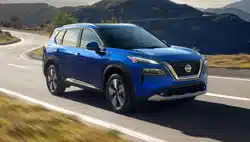Loading ...
Loading ...
Loading ...

lane marker. If this occurs you
may need to apply corrective
steering to complete your lane
change.
. Because the I-LI may not activate
under the road, weather, and lane
marker conditions described in
this section, it may not activate
every time your vehicle begins to
leave its lane and you will need to
apply corrective steering.
. The I-LI system will not operate at
speeds below approximately 37
MPH (60 km/h) or if it cannot
detect lane markers.
. When the I-LI system is operating,
avoid excessive or sudden steer-
ing maneuvers. Otherwise, you
could lose control of the vehicle.
. Do not use the I-LI system under
the following conditions as it may
not function properly:
— During bad weather (rain, fog,
snow, etc.).
— When driving on slippery
roads, such as on ice or snow.
— When driving on winding or
uneven roads.
— When there is a lane closure
due to road repairs.
— When driving in a makeshift or
temporary lane.
— When driving on roads where
the lane width is too narrow.
— When driving without normal
tire conditions (for example,
tire wear, low tire pressure,
installation of spare tire, tire
chains, non-standard wheels).
— When the vehicle is equipped
with non-original brake parts
or suspension parts.
— When towing a trailer or other
vehicle.
— On roads where there are
multiple parallel lane markers;
lane markers that are faded or
not painted clearly; yellow
painted lane markers; non-
standard lane markers; or
lane markers covered with
water, dirt, snow, etc.
— On roads where discontinued
lane markers are still detect-
able.
— On roads where there are
sharp curves.
— On roads where there are
sharply contrasting objects,
such as shadows, snow,
water, wheel ruts, seams or
lines remaining after road re-
pairs. (The I-LI system could
detect these items as lane
markers.)
— On roads where the traveling
lane merges or separates.
— When the vehicle’s traveling
direction does not align with
the lane marker.
— When traveling close to the
vehicle in front of you, which
obstructs the lane camera
unit detection range.
— When rain, snow or dirt ad-
heres to the windshield in
front of the lane camera unit.
— When the headlights are not
bright due to dirt on the lens
or if the aiming is not adjusted
properly.
— When strong light enters the
lane camera unit. (For exam-
ple, the light directly shines on
the front of the vehicle at
sunrise or sunset.)
Starting and driving 5-55
Loading ...
Loading ...
Loading ...
